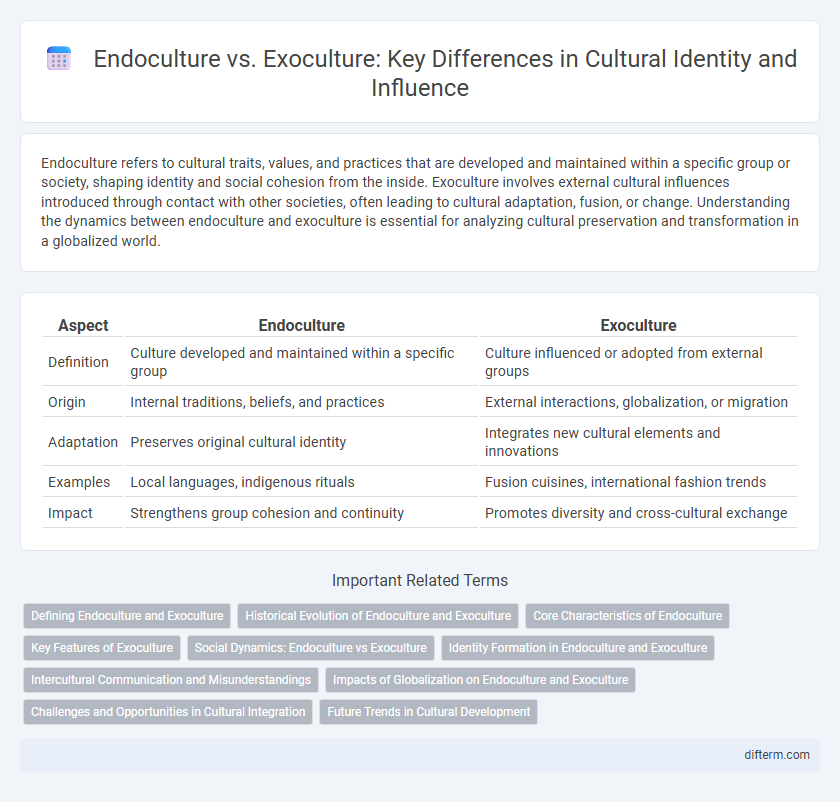Endoculture refers to cultural traits, values, and practices that are developed and maintained within a specific group or society, shaping identity and social cohesion from the inside. Exoculture involves external cultural influences introduced through contact with other societies, often leading to cultural adaptation, fusion, or change. Understanding the dynamics between endoculture and exoculture is essential for analyzing cultural preservation and transformation in a globalized world.
Table of Comparison
| Aspect | Endoculture | Exoculture |
|---|---|---|
| Definition | Culture developed and maintained within a specific group | Culture influenced or adopted from external groups |
| Origin | Internal traditions, beliefs, and practices | External interactions, globalization, or migration |
| Adaptation | Preserves original cultural identity | Integrates new cultural elements and innovations |
| Examples | Local languages, indigenous rituals | Fusion cuisines, international fashion trends |
| Impact | Strengthens group cohesion and continuity | Promotes diversity and cross-cultural exchange |
Defining Endoculture and Exoculture
Endoculture refers to the cultural values, norms, and practices that are shared and reinforced within a specific group or society, emphasizing internal cohesion and identity. Exoculture involves the adoption or influence of external cultural elements that originate outside the primary cultural group, often leading to cross-cultural exchange or transformation. Understanding the distinction between endoculture and exoculture is essential for analyzing cultural dynamics and identity preservation within social groups.
Historical Evolution of Endoculture and Exoculture
Endoculture and exoculture have evolved distinctly throughout history, with endoculture originating from internal societal practices and traditions that shape group identity and social cohesion over time. Exoculture developed through external influences such as trade, conquest, and migration, incorporating foreign elements into a community's cultural framework. The interplay between endoculture and exoculture reflects historical patterns of cultural preservation and adaptation, highlighting the dynamic processes of cultural evolution.
Core Characteristics of Endoculture
Endoculture is characterized by inward-focused values prioritizing tradition, social cohesion, and communal identity within a group. It emphasizes preserving established norms, rituals, and language unique to the community. This cultural model supports strong group loyalty and resistance to external influences, promoting internal stability and continuity.
Key Features of Exoculture
Exoculture involves cultural elements and practices that originate outside an individual's immediate environment, emphasizing adaptation and integration of foreign customs and ideas. Key features include cultural borrowing, cross-cultural interaction, and the blending of diverse traditions to create novel social norms. This dynamic process promotes innovation, intercultural understanding, and the evolution of hybrid identities within a globalized context.
Social Dynamics: Endoculture vs Exoculture
Endoculture emphasizes social cohesion by reinforcing shared values, norms, and traditions within a specific group, fostering strong internal bonds and collective identity. Exoculture involves interaction with external cultures, promoting adaptability and social innovation through exposure to diverse perspectives and practices. Understanding the balance between endocultural stability and exocultural openness is crucial for managing social dynamics in multicultural societies.
Identity Formation in Endoculture and Exoculture
Endoculture shapes identity through internalized values, traditions, and norms passed down within a cultural group, reinforcing a collective sense of belonging and continuity. Exoculture influences identity by introducing external cultural elements and interactions that challenge or blend with native cultural frameworks, leading to hybrid or transformed identities. The dynamic interplay between endocultural continuity and exocultural adaptation drives complex identity formation processes in multicultural environments.
Intercultural Communication and Misunderstandings
Endoculture refers to the culture within a specific group, while exoculture encompasses external cultural influences and interactions. Intercultural communication often faces misunderstandings due to differing endocultural norms and exocultural perceptions that affect interpretation and behavior. Effective intercultural communication requires awareness of both endocultural values and exocultural contexts to reduce misinterpretations and foster mutual understanding.
Impacts of Globalization on Endoculture and Exoculture
Globalization profoundly reshapes endoculture by accelerating cultural exchange and integration within local communities, often leading to the blending or erosion of traditional customs and values. Exoculture experiences increased visibility and influence through global media, tourism, and digital connectivity, expanding the reach and adaptation of external cultural elements across borders. The dynamic interplay between endoculture and exoculture under globalization drives cultural hybridity, while simultaneously raising critical concerns about cultural preservation and identity.
Challenges and Opportunities in Cultural Integration
Endoculture emphasizes preserving internal cultural identity, confronting challenges like resistance to external influences and potential cultural stagnation. Exoculture promotes embracing external cultural elements, offering opportunities for innovation but facing risks of cultural dilution and identity loss. Successful cultural integration depends on balancing these approaches to foster diversity while maintaining core cultural values.
Future Trends in Cultural Development
Future trends in cultural development reveal a gradual blending of endoculture, which emphasizes internal group traditions and values, with exoculture, characterized by the adoption of external influences and innovations. The rise of digital communication platforms accelerates cross-cultural interactions, fostering hybrid cultural identities that balance preservation with adaptation. Emerging technologies like virtual reality also enable immersive cultural experiences, promoting both global understanding and localized cultural expression.
Endoculture vs Exoculture Infographic

 difterm.com
difterm.com